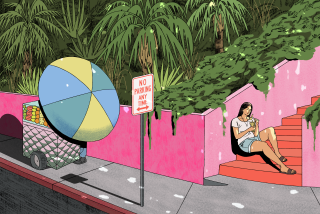‘The Lovers’ by Vendela Vida
- Share via
The Lovers
A Novel
Vendela Vida
Ecco: 228 pp., $23.99
The Mediterranean beach setting and amorous title may give the impression that Vendela Vida’s new book, “The Lovers,” is a sexy vacation read. Not quite: There is a bit of romance, but it’s just one of several kinds of love that are addressed in this novel, Vida’s third.
Like 2007’s “Let the Northern Lights Erase Your Name,” Vida’s “The Lovers” follows a woman who travels far from home on an emotional quest. This time, it’s Yvonne, a 53-year-old high school history teacher from Vermont; her destination is the coast of Turkey.
Yvonne’s husband, Peter, was killed two years prior, and widowhood has left her subdued, perhaps more than she realizes. Their two adult children figure large in Yvonne’s mental landscape: twins who couldn’t be more different, daughter Aurelia is troubled, in and out of rehab, while Matthew has had a lifetime of easy successes.
Matthew’s invitation to come along on a European tour with his fiancée and her family spurs Yvonne’s trip. She plans to meet them partway through, first spending nine days on her own in a house she rents in the Turkish town of Datça — which is later revealed to be where she and Peter honeymooned.
The house is a multifloored modern, and among its amenities is sex gear that Yvonne finds puzzling and disturbing. The place is too big for her, and she haunts it, sleeping in one room and then another. She’s never entirely alone, though — there are visits from a maid, the landlord and his wife, Özlem, who soon becomes a confidante.
Yvonne hasn’t reconciled herself to Peter’s death, and she can’t forgive herself for wishing it might damage others as it’s damaged her. On the surface, her offenses are small: her attentive teaching has fallen off and she lies to friends to cover up her solitude. But she is driven by a sense that something is deeply wrong. In Datça, she hopes she might bring memories of her husband to life and connect to her former self.
“Here, with Peter she had been generous and world-welcoming. Here, with Peter, everything had been lovely. The promenade was lovely. The water was lovely. The food was lovely. The rain, the feral cats, the keys to their hotel that they’d lost and looked for all day — it was all lovely.”
Not surprisingly, Datça has changed — the beach is trash-strewn, the shops are closed, the restaurants grim. But if the setting parallels her mental state, she does find escape — in a restorative cove down the peninsula, at Knidos.
There she finds a friendly couple who conduct boat tours; they bring her to Sedir Adasi, also known as Cleopatra’s Island, a legendary rendezvous site for Antony and Cleopatra, who made love there on sand brought in from Egypt. The island’s romantic history holds little promise for Yvonne, as does the Marguerite Duras book “The Lover,” which she has brought with her. For all the kinds of love she encounters in her travels, she craves, more than anything else, the platonic.
Yvonne’s emotions are soon wrapped up with Ahmet, a Turkish boy she befriends on the beach at Knidos. They share little language, but she quickly develops a genuine affection for him, viewing him both maternally and as a companion. This leads to trouble, and Yvonne’s hopes for coming to a greater peace start to spiral away.
As much as Yvonne’s cloudy emotional state gives the story an interesting center, around the edges it is strangely flat. Everything is exactly as it seems: a mean waiter is mean, beautiful Özlem is kind, dilapidated Datça is unpleasant, taxi drivers explain the countryside as straightforwardly as a tour book.
This is not a book for armchair tourists: While ruins are rendered with detail, the cultural experience is a pale shadow behind Yvonne’s emotional reckonings. She goes hungry and eats junk food more often than she tries the local cuisine, and she’s interested in the individuals she meets, not the society in which they live.
Yvonne is the only part of the book with complexity, while everything she encounters in Turkey is surface. This may be a smart novelist’s trick, using an exotic location as an emotional map. But it also makes the book feel like it could have been set in Trenton or Detroit or Coalinga — any place both a desolate landscape and a refuge of renewal. Instead, what we get is an uncomfortable act of novelistic imperialism: the exotic land, its sites manipulated to reflect the disarranged emotional life of the American tourist, all without a sense of the place having its own history, its own cultural life — and its own tragedies.
Kellogg is lead blogger for Jacket Copy, The Times’ book blog.
More to Read
The biggest entertainment stories
Get our big stories about Hollywood, film, television, music, arts, culture and more right in your inbox as soon as they publish.
You may occasionally receive promotional content from the Los Angeles Times.











